
News |
- Global Water Demands Soar: Increase Risk
- Ring of Fire First Nations to Evict Companies
- $18 M for Lake Winnipeg, Zilch for ELA
- Enbridge Spills Again: Regulators Close System, Minister Questions Pipeline
- Lake Winnipeg Phase II Clean-up Announced
- Canada 2nd Last on Energy Efficiency
- Treaty Two Serves Notice: Peat Mines & Irrigation
- Objections to Sunterra Peat Mine Received
- Hydro Applies for More Rate Increases
- Organic Fight Against Monsanto Grows
- Peoples' Sustainability Manifesto
- Environment Statement for Keeyask Dam Filed
| Global Water Demands Soar: Increase Risk | 17 August 12 |
 Nearly one quarter of the world's population lives where groundwater is being used faster than it can be replaced. A recently published analysis calculates current global overuse of groundwater and shows aquifers are most in danger.
Nearly one quarter of the world's population lives where groundwater is being used faster than it can be replaced. A recently published analysis calculates current global overuse of groundwater and shows aquifers are most in danger."This overuse can lead to decreased groundwater availability for both drinking water and growing food," says Tom Gleeson, a hydro-geologist at McGill University in Montreal, Quebec, and lead author of the study. A major report, Charting Our Water Future, calculates by 2030 global water demand could outstrip supply by 40%. Not only are water supplies facing pressure from food industries, but the energy industry is facing water shortage unless changes in technologies and usage happen. The World Policy Institute has published a paper that examines convergence of the energy industry with current water usage. The findings include: that petroleum from the Canadian oil sands extracted via surface mining techniques can consume 20 times more water than conventional oil drilling. As well the paper talks about how irrigated first-generation soy- and corn-based biofuels can consume thousands of times more water than traditional oil drilling, primarily through irrigation. View August 8, 2012 Nature articleView March 22 World Policy Institute release View National Geographic article View November 12, 2010 The Guardian article View November 19, 2008 The Economist article |
|
 Print version Print version |
Top |
| Ring of Fire First Nations to Evict Companies | 3 August 12 |
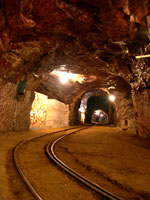 US mining giant Cliffs Natural Resources announced, in May 2012, plans for a $3.3Billion project including a chromite mine east of Webequie, a transportation route running south from the mine site and a ferrochrome processing plant in Sudbury, Ontario. The proposed open pit mine site is in an area called "The Ring of Fire", roughly 540 kilometres North of Thunder Bay in the James Bay lowlands. The proposal for Cliffs to remove up to 12,000 tons of ore a day.
US mining giant Cliffs Natural Resources announced, in May 2012, plans for a $3.3Billion project including a chromite mine east of Webequie, a transportation route running south from the mine site and a ferrochrome processing plant in Sudbury, Ontario. The proposed open pit mine site is in an area called "The Ring of Fire", roughly 540 kilometres North of Thunder Bay in the James Bay lowlands. The proposal for Cliffs to remove up to 12,000 tons of ore a day.The Ring of Fire is an area exceedingly rich in minerals and precious metals. It is situated in First Nations Traditional Territories around McFaulds Lake in Northern Ontario. First Nations in the region responded quickly, without hesitation. Six First nations are preparing eviction notices for all mining companies in the Ring of Fire. Aroland, Constance Lake, Ginoogaming , Long Lake 58, Neskantaga and Nibinamik plan to give the companies 30 days to cease all activity. Over the past two years Ring of Fire Chiefs have been ignored while calling for government to government consultations. "When a First Nation's right to free, prior, and informed consent is ignored the consequences are devastating" said Ontario Regional Chief Stan Beardy. "I support Matawa First Nations and its member Nation, Neskantaga, in their recent legal challenges and ask the provincial government to reconsider the position it has taken in these disputes." View July 21, 2012 Greenpeace articleView July 13, 2012 Indigenous Peoples Issues and Resources article View June 8, 2012 CBC News article View June 25, 2012 MiningWatch Canada article View May 15, 2012 CBC News article View May 17, 2012 Wawatay News article View March 2008 United Nations presentation (PDF) View August 9, 2012 Indigenous Peoples Issues and Resources article Source:
Greenpeace, CBC, United Nations
|
|
 Print version Print version |
Top |
| $18 M for Lake Winnipeg, Zilch for ELA | 3 August 12 |
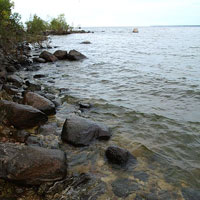 Canadian Prime Minister Stephen Harper arrived in Gimli, Manitoba on August 2, 2012 to announce funding for the Lake Winnipeg Basin Initiative (LWBI), but was met by a cadre of citizens' upset by the Government's recent decision to pull the plug on funding for northwestern Ontario's Experimental Lakes Area (ELA).
Canadian Prime Minister Stephen Harper arrived in Gimli, Manitoba on August 2, 2012 to announce funding for the Lake Winnipeg Basin Initiative (LWBI), but was met by a cadre of citizens' upset by the Government's recent decision to pull the plug on funding for northwestern Ontario's Experimental Lakes Area (ELA)."Our priority in this area is this particular project [LWBI] and obviously we're not intending to continue that other project [ELA]," retorted the Prime Minister. Dian Orihel, the leader of the Coalition to Save the ELA supports the new funding, but added: "The ELA is pivotal to the health of Lake Winnipeg." "Funding Lake Winnipeg research without funding ELA is like sending rowers to the Olympics without oars," said Jon Gerrard, Manitoba's Liberal leader. "Much of the fundamental understanding of nutrient management in lakes so critical to the recovery of Lake Winnipeg has and is being developed at the ELA," said Ray Hesslein of the Lake Winnipeg Foundation science advisory board. Located in northwestern Ontario and founded in 1968 ELA includes 58 lakes and their watershed. Most lakes are monitored to provide baseline control data. This has provided an invaluable 44 year data set on more than 40 lakes. By manipulating and studying conditions in some of the non-control lakes and their watersheds, scientists there have made many discoveries with real world impact. Some key areas of influence have been in understanding and managing algal blooms, acid rain, climate change, mercury pollution, greenhouse gas fluxes from hydroelectric reservoirs, and endocrine-disrupting chemicals. View August 3, 2012 Winnipeg Free Press coverageView August 2, 2012 CBC coverage View August 2, 2012 CTV coverage View August 2, 2012 Jon Gerrard blog post View Save The Experimental Lakes Areas website View May 25, 2012 Manitoab Wildlands news item Source:
Winnipeg Free Press
|
|
 Print version Print version |
Top |
| Enbridge Spills Again: Regulators Close System, Minister Questions Pipeline | 3 August 12 |
 Another spill has occurred on a pipeline operated by Canadian Company Enbridge Inc.
Another spill has occurred on a pipeline operated by Canadian Company Enbridge Inc.Approximately 200,000 litres (1,200 barrels) of bitumen spilled from a pipeline in rural Wisconsin July 27, 2012. The spill occurred on a leg of Enbridge's Lakehead Pipeline System, which transports oil from Neche, N.D., to Chicago, Ill., and to Buffalo, NY. Lakehead Pipeline System is the same system that failed July 25, 2010, leading to a massive 3.2 million-litre (20,000 barrel) oil spill into Michigan's Kalamazoo River. In response the U.S. Transportation Department's Pipeline and Hazardous Materials Safety Administration (PHMSA) has ordered Enbridge to perform a comprehensive safety review of its entire 1,900-mile Lakehead oil delivery system before it can operate again. "We want to be sure the operator is addressing everything they can for the entire system so it operates safely," said PHMSA spokesman Damon Hill. These reports and spills raise concerns about the safety of Enbridge's plan to build a pipeline to deliver crude bitumen from the Alberta oilsands to tankers on the B.C. coast. Environmental review hearings are underway and the federal government has set a Dec. 31, 2013 deadline for the panel's report on the Northern Gateway project. Canada's Conservative government is a strong supporter of the Northern Gateway Pipeline, but in the wake of Enbridge's spill in Wisconsin Canadian Heritage Minister James Moore has questioned Enbridge's safety record as: "not one that ... any other company should follow if they want to do business in British Columbia." Moore's comments are significant because this is the first time any top Canadian government official has questioned the Enbridge Northern Gateway Pipeline. View August 3, 2012 Planet Ark coverageView August 3, 2012 Financial Post coverage View August 2, 2012 The Globe and Mail article View August 2, 2012 Inside Climate News View August 1, 2012 U.S. Transportation Department's Pipeline and Hazardous Materials Safety Administration Order to Enbridge (PDF) View July 13, 2012 Manitoba Wildlands news item View Manitoba Wildlands Energy Development page Source:
Inside Climate News, Planet Ark, Financial Post, CTV
|
|
 Print version Print version |
Top |
| Lake Winnipeg Phase II Clean-up Announced | 3 August 12 |
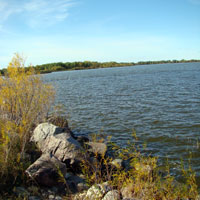 Prime Minister Stephen Harper announced a Government of Canada five-year $18 million commitment to help fund the second phase of the Lake Winnipeg Basin Initiative (LWBI) August 2, 2012. For every dollar Ottawa spends, the province and other partners in the clean-up pitch in $2, Harper said.
Prime Minister Stephen Harper announced a Government of Canada five-year $18 million commitment to help fund the second phase of the Lake Winnipeg Basin Initiative (LWBI) August 2, 2012. For every dollar Ottawa spends, the province and other partners in the clean-up pitch in $2, Harper said.For first phase of the LWBI (2008-2012), Canada and Manitoba signed a Memorandum of Understanding (MOU) on long-term collaboration to improve the health of Lake Winnipeg. The first phase funded research to investigate water quality issues within the lake and its watershed. Through these efforts, the initiative was able to fill important gaps in research, data collection and monitoring of the lake's ecology and sources and movement of nutrients that contribute to the large and persistent algae blooms seen in recent years. Phase I included funding Sensitive Habitat Inventory and Mapping (SHIM) along the South Basin of Lake Winnipeg, a project of the Lake Winnipeg Foundation. Phase II of the LWBI (2012-2017) will build on scientific accomplishments of Phase I and will move towards taking greater action to address water quality issues, including:
View August 2, 2012 Government of Canada press release on First Perspective View August 2, 2012 CBC coverage View August 2, 2012 CTV coverage View May 23, 2012 Lisette Ross Native Plant Solutions presentation (PDF) View Sensitive Habitat Inventory and Mapping (SHIM) Study on Lake Winnipeg Foundation website Source:
First Perspective, Winnipeg Free Press
|
|
 Print version Print version |
Top |
| Canada 2nd Last on Energy Efficiency | 3 August 12 |
 Canada placed second from last out of 12 countries on a recent American Council for an Energy-Efficient Economy (ACEEE) energy efficient score card.
Canada placed second from last out of 12 countries on a recent American Council for an Energy-Efficient Economy (ACEEE) energy efficient score card.The 12 countries assessed account for 63 per cent of global energy consumption as well as 62 per cent of the world's carbon dioxide emissions. The United Kingdom topped the list, followed by Germany and Italy. The United States was ranked 9th out of 12, ahead of Brazil (10th), Canada (11th), and Russia (12th). ACEEE ranked countries using 27 metrics, including: amount of energy consumed relative to gross domestic product, miles-per-gallon ratings for vehicles, energy use per square foot for floor space in residential buildings, and more. Steven Nadel, executive director of the ACEEE, lauded the UK and the EU for being "well ahead" of North America for its energy efficiency but cautioned that none of the countries received a perfect score in any category. "Unfortunately," said Nadel, "our results show that nowhere is the vast potential for improvements in energy efficiency being completely realized." View 2012 ACEEE International Energy Efficiency ScorecardView July 16, 2012 CBC coverage View July 16, 2012 Environmental News Service coverage View July 12, 2012 Los Angeles Times coverage Source:
American Council for an Energy-Efficient Economy (ACEEE)
|
|
 Print version Print version |
Top |
| Treaty Two Serves Notice: Peat Mines & Irrigation | 27 July 12 |
 Chief Norman Bone, co-chair of the Treaty 2 First Nations known collectively as Anishinaabe Agawidiiwinan, has served notice to the Honourable Gord Mackintosh that they regard pending provincial government decisions regarding new peat mines as having strong potential for serious negative impacts on the rights and of the First Nations.
Chief Norman Bone, co-chair of the Treaty 2 First Nations known collectively as Anishinaabe Agawidiiwinan, has served notice to the Honourable Gord Mackintosh that they regard pending provincial government decisions regarding new peat mines as having strong potential for serious negative impacts on the rights and of the First Nations."We believe it is incumbent upon the Government to abstain from any decisions that would result in the issuing of any peat licenses until such time as its constitutionally mandated duties have been fulfilled," said Chief Bone. Canadians are increasingly aware of the severe environmental issues associated with peat. For centuries peat was used as a source of fuel, and in modern times it is commonly used as a growing medium in gardening. Environment scientists are warning, however, that peat mining is an incredibly destructive and unnecessary industry. Also the entire watershed of the Little Saskatchewan River is within the boundaries of Treaty No. 2 in which the First Nations agreed to share their lands for purposes of "immigration and settlement." On July 5, 2012 the Government of Manitoba issued Environment Act License No. 3010 to the "Daly Irrigation Development Group" for the construction and operation of an irrigation system in the Rural Municipality of Daly. Chief Norman Bone therefore also served notice to Gord Mackintosh that they regard the provincial government's decision to issue a license to the Daly Irrigation Development Groups as having strong potential for serious negative impact on the rights and interests of First Nations. "We believe it is incumbent upon the Government to stay the license until such time as its duties have been fulfilled," Chief Bone said in the Treaty 2 notice. The river's fragile ecosystem provides critical habitat for several endangered and at-risk species. View July 27, 2012 Treaty Two Press Release on Peat Mines (PDF)View July 27, 2012 Treaty Two Press Release on Little Saskatchewan Irrigation (PDF) View Manitoba Wildlands Aboriginal Rights & Title, Treaties & Traditional Territory page Source:
Treaty Two
|
|
 Print version Print version |
Top |
| Objections to Sunterra Peat Mine Received | 27 July 12 |
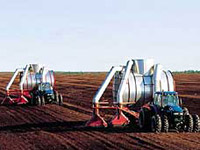 Several hundred formal of objections, and petitions with several hundred signatures were sent to Manitoba Conservation & Water Stewardship Minister Gord Mackintosh by July 24, 2012. All are in opposition to the application by Sunterra Horticulture Inc. to expand peat mining operations in the Bullhead, Little Deer Lake and Ramsay Point Bogs, located approximately 40 and 80 km north of Riverton, Manitoba.
Several hundred formal of objections, and petitions with several hundred signatures were sent to Manitoba Conservation & Water Stewardship Minister Gord Mackintosh by July 24, 2012. All are in opposition to the application by Sunterra Horticulture Inc. to expand peat mining operations in the Bullhead, Little Deer Lake and Ramsay Point Bogs, located approximately 40 and 80 km north of Riverton, Manitoba.The proposed peat mine will result in approximately 1324 hectares (ha) of land clearing, with 715 ha being mined directly. The proposed peat mine expansion is located within the traditional territories of Bloodvein River First Nation, Fisher River First Nation, and within both the traditional territory and treaty land entitlement notification zone of Peguis First Nation. Adequate consultations between the Crown and the affected First Nations have not yet taken place. The proposed mine site also includes t is also within the Moose Lake Wildlife Management Area (WMA) and in close proximity to Beaver Creek Provincial Park. View July 24, 2012 H20 blog postView July 24, 2012 Karin Boyd, Lake Winnipeg Foundation letter (PDF) View July 24, 2012 James Beddome, Green Party of Manitoba letter View July 23, 2012 Gaile Whelan Enns, Manitoba Wildlands Letter (PDF) View July 23, 2012 Mike Sutherland, Peguis First Nation letter (PDF) View July 23, 2012 Dr. Heather Hinam, Second Nature Discoveries in Adventure letter (PDF) View July 23, 2012 Vicki Burns, Lake Winnipeg Project letter (PDF) View July 23, 2012 Mo Tipples, Grindstone Cottagers Association letter (PDF) View July 15, 2012 Wilderness Committee page View Environment Act Public Registry File #4254.10 online View Manitoba Wildlands Peat Mining in Manitoba page Source:
Government of Manitoba
|
|
 Print version Print version |
Top |
| Hydro Applies for More Rate Increases | 27 July 12 |
 Manitoba Hydro is again asking the Public Utilities Board to increase electricity rates in Manitoba.
Manitoba Hydro is again asking the Public Utilities Board to increase electricity rates in Manitoba.The Public Utilities Board already granted an interim 2 per cent increase in electricity rates for all customers. Now Hydro is seeking to have that interim order finalized and further increase electricity rates 2.5 per cent electricity effective Sept. 1, 2012, and another 3.5 per cent on April 1, 2013. Additionally Manitoba Hydro is applying for a 6.5 per cent increase in electricity rates for customers in four remote communities served by diesel generation. Without the additional money, Hydro said it would see a net loss of $51 million in the next fiscal year and $58 million in 2013-14. The proposed rate increases come as Hydro heads into a multi-year plan to build the controversial Bipole III transmission line and two new northern generating stations. Supplying more power to Wisconsin and Minnesota requires all three projects. Increased revenues are required to support the ongoing reliability of electricity service to Manitobans," said Scott Thomson, Hydro's president and CEO, adding, "Manitoba consumers will continue to have electricity rates that are among the lowest in North America." In Saskatchewan and Ontario users pay electricity rates that are more than 50 per cent higher than in Manitoba, while consumers in North Dakota and Minnesota pay rates 30 to 40 per cent higher. View July 14, 2012 Public Utilities Board Winnipeg Free Press advertisement (PDF)View June 15, 2012 Manitoba Hydro Cover Letter for 2012/13 & 2013/14 General Rate Application (PDF) View June 15, 2012 Metro News coverage View June 15, 2012 Winnipeg Free Press View June 15, 2012 Steinbach Online article View Manitoba Hydro 2012/13 & 2013/14 General Rate Application page View Manitoba Public Utility Board 2012 Board Orders on Hydro Electricity Source:
Manitoba Hydro & Metro News
|
|
 Print version Print version |
Top |
| Organic Fight Against Monsanto Grows | 27 July 12 |
 A class action lawsuit against Monsanto representing over 300,000 individuals and 4,500 farms against Monsanto continues to gain support as it works its way towards the US Court of Appeals. The plaintiff farmers, seed businesses and agricultural organizations are seeking a protective legal ruling that Monsanto cannot sue them for patent infringement if Monsanto's genetically modified seed contaminates their crops.
A class action lawsuit against Monsanto representing over 300,000 individuals and 4,500 farms against Monsanto continues to gain support as it works its way towards the US Court of Appeals. The plaintiff farmers, seed businesses and agricultural organizations are seeking a protective legal ruling that Monsanto cannot sue them for patent infringement if Monsanto's genetically modified seed contaminates their crops.On July 18, 2012 eleven prominent law professors and fourteen renowned organic, biodynamic, food safety and consumer non-profit organizations have filed separate briefs with the Court of Appeals for the Federal Circuit arguing farmers have the right to protect themselves from being accused of patent infringement by agricultural giant Monsanto. The suit was originally filed in the New York courts in March 2011, but was dismissed February 24, 2012. The presiding judge found that the plaintiffs had "no injury traceable to defendants" and did not present an immediate controversy worthy of declaratory relief. The February 24, 2012 ruling was quickly appealed on March 28, 2012. "The law says we deserve protection under the Declaratory Judgment Act. We will continue to pursue our right to farm, and the right of our customers to have access to good clean food and seed", said Jim Gerritsen, President of lead plaintiff Organic Seed Growers and Trade Association (OSGATA). Every year Monsanto investigates over 500 farmers for patent infringement with their now notorious "seed police." To date, 144 farmers without contracts with Monsanto have had lawsuits brought against them by Monsanto, while another 700 farmers have been forced to settle out of court for undisclosed sums. "It's time to end Monsanto's scorched-earth campaign of frivolous lawsuits against America's family farmers. Monsanto's claims against farmers for patent infringement are exceedingly weak, violating Americans' most basic sense of fairness and decency. Our Founding Fathers would be outraged", said Dave Murphy, founder and executive director of Food Democracy Now! View July 18, 2012 Organic Seed Growers and Trade Association (OSGATA) press releaseView July 9, 2012 Kane Bio Law Blog View July 7, 2012 Press TV coverage View July 5, 2012 Organic Seed Growers and Trade Association (OSGATA) press release View March 29, 2012 Organic Seed Growers and Trade Association (OSGATA) blog View Public Patent Foundation OSGATA v. Monsanto: Seed Patents page View February 17, 2012 Manitoba Wildlands coverage Source:
Organic Seed Growers and Trade Association (OSGATA), Public Patent Foundation, Press TV.
|
|
 Print version Print version |
Top |
| Peoples' Sustainability Manifesto | 20 July 12 |
 Hundreds of civil society organizations converged in Brazil to unveil the "Peoples' Sustainability Manifesto" the final day of the United Nations Rio+20 Summit June 22, 2012. The Manifesto evolved through a consultative process for fourteen Peoples' Sustainability Treaties.
Hundreds of civil society organizations converged in Brazil to unveil the "Peoples' Sustainability Manifesto" the final day of the United Nations Rio+20 Summit June 22, 2012. The Manifesto evolved through a consultative process for fourteen Peoples' Sustainability Treaties.The Manifesto reads: "We, the signatories to this Manifesto, refuse to sit idly by in the face of another failure of governments to provide hope for a sustainable future for all. ... We pledge ourselves to: equity ... localizing our systems of economies ... [and] a Global Citizens Movement." "It's fitting that we're launching the process in Rio de Janeiro, twenty years on from the 1992 Earth Summit. Governments at Rio are talking about institutional frameworks for sustainable development and the green economy. But these efforts will not succeed unless we also pay attention to the health of the world's dominant political system – democracy," stated Co-Chair of the Foundation for Democracy and Sustainable Development (FDSD) John Lotherington, whose organization lead the manifesto development process. A public consultation process, soliciting feedback to finalize the Peoples' Sustainability Manifesto, will run until the end of November 2012. FDSD is also looking for champions of the manifesto, which is scheduled to officially launch in early 2013. Sign the Peoples Sustainability ManifestoView Peoples' Sustainability Treaties on OccupyRio+20 page View June 22, 2012 People's Sustainability Manifesto press release View June 8, 2012 International Institute for Environment and Development coverage View June 8, 2012 Foundation for Democracy and Sustainable Development press release Source:
Peoples' Sustainability Manifesto, Foundation for Democracy and Sustainable Development
|
|
 Print version Print version |
Top |
| Environment Statement for Keeyask Dam Filed | 20 July 12 |
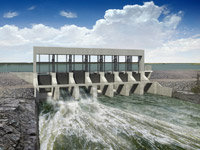 The Keeyask Hydro Power Limited Partnership (between Manitoba Hydro and four Manitoba First Nations) filed the Environmental Impact Statement (EIS) to seek a Manitoba Environment Act license for the proposed Keeyask Hydroelectric Dam July 6, 2012.
The Keeyask Hydro Power Limited Partnership (between Manitoba Hydro and four Manitoba First Nations) filed the Environmental Impact Statement (EIS) to seek a Manitoba Environment Act license for the proposed Keeyask Hydroelectric Dam July 6, 2012.The public has until September 20, 2012 to provide comments as announced by Manitoba Conservation and Water Stewardship Environmental Approvals Branch in the July 14, 2012 edition of the Winnipeg Free Press. The Keeyask Hydro Power Limited Partnership previously filed an Environment Act Proposal Form (EAPF) and a "Scoping Document for the Environmental Assessment of the Keeyask Generation Project" with Manitoba Conservation Environmental Approvals Branch December 9, 2011. Manitoba Wildlands provided comments on February 3, 2012. The application for an interim Water Power Act license for the Keeyask dam was filed February 8, 2012. The public has until August 31, 2012 to provide comments to Manitoba Conservation and Water Stewardship Water Use Licensing Section as also announced in the July 14, 2012 Winnipeg Free Press. Modern dams in Manitoba require at least three licenses. Two licenses from the Manitoba government: a Water Power Act license, and an Environment Act License; plus a federal license under the Canadian Environmental Assessment Act (CEAA). Export of any energy from the Keeyask dam would also require a permit from the Nation Energy Board. View July 14, 2012 Winnipeg Free Press Advertisements (PDF)View July 2012 Keeyask Environmental Impact Statement View Manitoba Conservation Online Registry Manitoba Hydro - Keeyask Generation Project View Manitoba Conservation Keeyask Generating Station page View Canadian Environmental Assessment Agency, Online Registry reference number 11-03-64144 View March 9, 2012 Manitoba Wildlands news item View December 16, 2011 Manitoba Wildlands news item View Manitoba Wildlands February 3, 2012 comments to Manitoba Conservation on draft Keeyask Scoping Document (PDF) View Manitoba Wildlands January 31 comments to Canadian Environmental Assessment Agency on Keeyask Background Information Document (PDF) View more information on Manitoba Wildlands Manitoba Hydro Projects page Source:
Manitoba Conservation & Water Stewardship, Canadian Environmental Assessment Agency
|
|
 Print version Print version |
Top |


 RSS Feeds:
RSS Feeds: